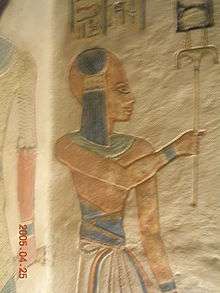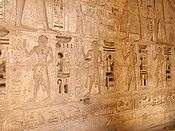Amun-her-khepeshef (20th dynasty)
Amun-her-khepeshef (also Amun-her-khepeshef B) was the eldest son and appointed heir of Pharaoh Ramesses III. Like at least another of his brothers, he was named after a son of Ramesses II, Amun-her-khepeshef. [1] He died when he was about fifteen years old.[2]
| Amun-her-khepeshef | |||||
|---|---|---|---|---|---|
 Amunherkhepeshef from his tomb QV55 | |||||
| Burial | QV55, Valley of the Queens, Thebes | ||||
| Egyptian name | |||||
| Dynasty | 20th of Egypt | ||||
| Father | Pharaoh Ramesses III | ||||
| Religion | Ancient Egyptian religion | ||||
| Amun-her-khepeshef in hieroglyphs |
|---|
- Not to be confused with Amun-her-khepeshef, a son of Ramesses II, Ramesses VI Amun-her-khepeshef and Amenherkhepshef, a son of Ramesses VI.

Amun-her-khepsef and other sons of Ramesses III
He is also mentioned as Ramesses Amun-her-khepeshef. He is not identical with his brother Ramesses VI, who was also called Amun-her-khepeshef before he became pharaoh.[1]
He is depicted in his father's temple at Medinet Habu.[1] His well preserved tomb, QV55 (in the Valley of the Queens) was excavated by Italian archaeologists in 1903–1904.[2]
Sources
- Aidan Dodson & Dyan Hilton, The Complete Royal Families of Ancient Egypt, (London: Thames & Hudson, 2004) ISBN 0-500-05128-3, p.192
- Alberto Siliotti: Guide to the Valley of the Kings. Barnes and Noble (1997). ISBN 88-8095-496-2
gollark: <@367460373932146692> UserBenchmark weighs multicore and stuff much less than it possibly should for "effective speed".
gollark: https://www.anandtech.com/show/12541/unlimited-5-year-endurance-100-tb-ssd
gollark: There was that one company making a 100TB SSD somehow.
gollark: Buy Western Digital and force them to invent and produce for you 20TB disks.
gollark: ASICs are where it's at for Bitcoin now.
This article is issued from Wikipedia. The text is licensed under Creative Commons - Attribution - Sharealike. Additional terms may apply for the media files.